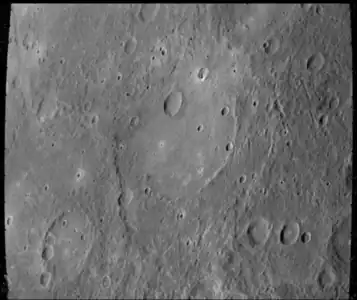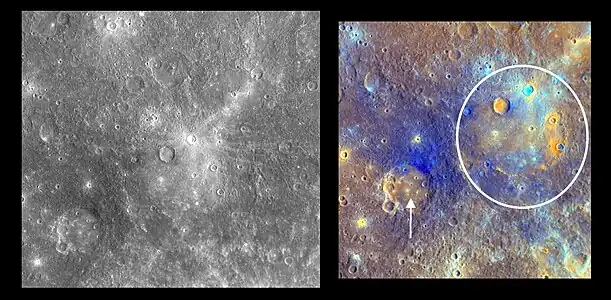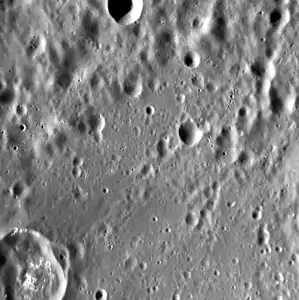 Enhanced-color image of Homer, with Dominici crater at top | |
| Planet | Mercury |
|---|---|
| Coordinates | 1°18′S 36°37′W / 1.3°S 36.62°W |
| Quadrangle | Kuiper |
| Diameter | 319 km (198 mi) |
| Eponym | Homer |
Homer is a crater on Mercury. It is one of 110 peak ring basins on Mercury.[1]
Deposits of material in and around this crater suggest the possibility of explosive volcanic eruptions at some point in the planet's history.[2] An unnamed crater in northwestern Homer (about 18 km diameter) contains hollows and has dark ejecta.
The crater name was approved by the IAU in 1976.[3] The naming of Stark Y crater on the Moon, located northwest of Stark, as Homer, was not approved by the IAU.[4]
The small but fresh crater Dominici lies along the northern margin of Homer. The crater Handel is to the northeast, and Titian is to the southwest.
 Mariner 10 image of Homer
Mariner 10 image of Homer Homer basin is marked with a white circle in the enhanced-color image. Nearby Titian crater is marked with an arrow.
Homer basin is marked with a white circle in the enhanced-color image. Nearby Titian crater is marked with an arrow.
References
- ↑ Chapman, C. R., Baker, D. M. H., Barnouin, O. S., Fassett, C. I., Marchie, S., Merline, W. J., Ostrach, L. R., Prockter, L. M., and Strom, R. G., 2018. Impact Cratering of Mercury. In Mercury: The View After MESSENGER edited by Sean C. Solomon, Larry R. Nittler, and Brian J. Anderson. Cambridge Planetary Science. Chapter 9.
- ↑ PSR Discoveries: Hot Idea: Mercury Unveiled
- ↑ Homer, Gazetteer of Planetary Nomenclature, International Astronomical Union (IAU) Working Group for Planetary System Nomenclature (WGPSN)
- ↑ SEDS: Homer (c. bet. 800 and 700 B.C.)
This article is issued from Wikipedia. The text is licensed under Creative Commons - Attribution - Sharealike. Additional terms may apply for the media files.